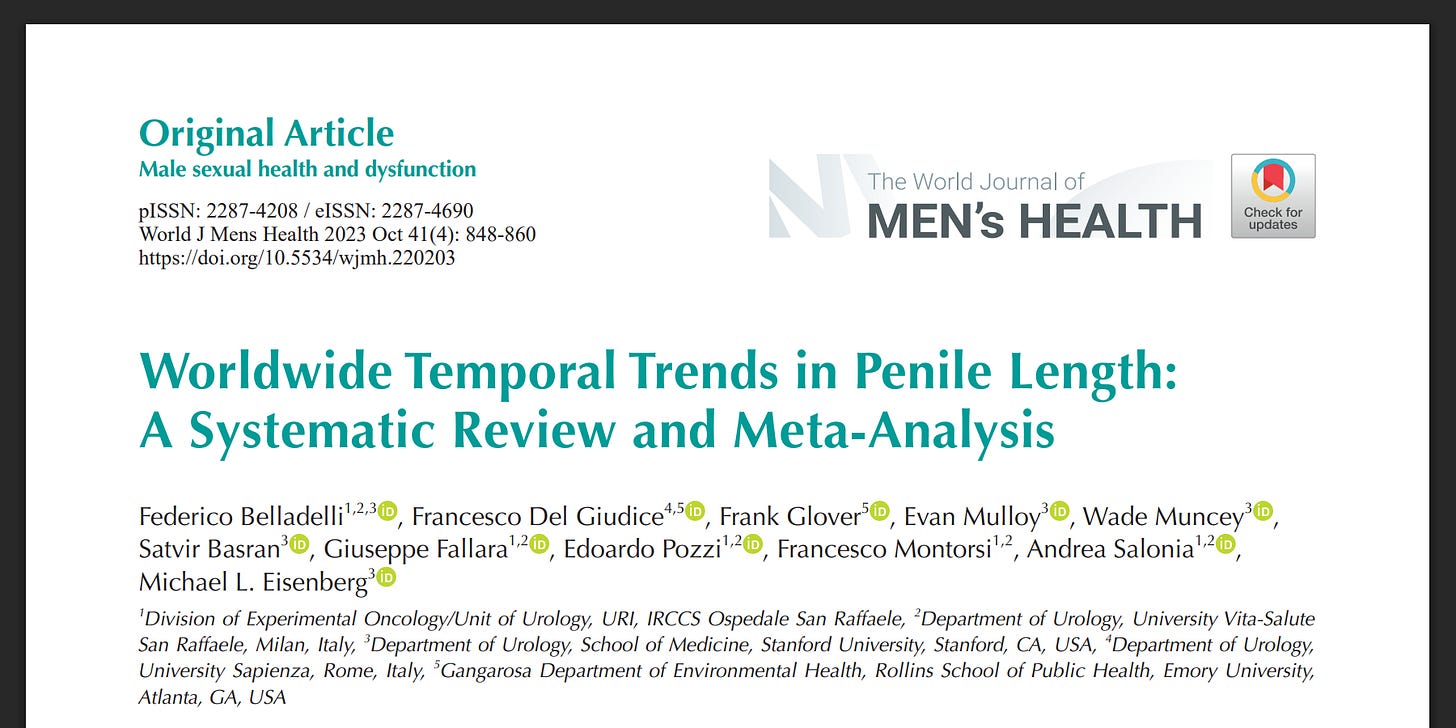Debunking the recent study that claimed penis size has increased (Part 1 – Background)
The systematic dismantlement and meta-deconstruction of a sensational claim that took the world by storm in 2023, that penis length has increased 24% over 29 years globally.
Background
In 2023, a study out of Stanford University’s department of urology took the news headlines by storm. The research was a systematic review and meta-analysis of penis size measurements in the scientific literature between 1942 and 2021. Drawing on data from 55,761 men worldwide, the researchers claimed to have discovered a surprising temporal trend: erect penile length has significantly increased over several decades.1
The study was conducted under the supervision of Dr. Michael Eisenberg of Stanford University, and led by Federico Belladelli who was a visiting research fellow at Stanford at the time. Google Scholar numbers show that Eisenberg, who graduated from Yale in 2004, has 14,327 citations of publications to his name. Belladelli, a young career researcher, has 1,664.
Based on the credentials of the authors, and given the importance of the study’s claim, you’d expect the results to be published in one of the top urology journals, like European Urology (h5-index = 121) or The Journal of Urology (h5-index = 79). It was instead published in The World Journal of Men’s Health from the Korean Society for Sexual Medicine and Andrology, which appears to be a B-tier journal (h5-index = 39) and is definitely a curious choice for such a monumental finding.
As a researcher, you always strive to submit your manuscripts to the best journal you think has a reasonable chance of accepting them, so the choice of the journal in this case suggests that the authors perhaps didn’t have enough confidence that their study would be accepted in one of the top journals. This suspicion prompted me to take a closer look at the paper.

When the study was published, news organizations and online magazines naturally jumped on the bandwagon. They quickly started writing articles talking about the groundbreaking finding, counting on the sensational nature of the claim to secure clicks. Social media influencers also found it to be good material for content creation. Even though the study was published in February 2023, people are still writing about it and sharing it online as of April 2025.
And who could blame them? The claim was indeed extraordinary: “Erect penile length increased by 24% over the 29 years of observation (from 12.27 cm to 15.23 cm [4.83 in to 6 in]).” That’s a whopping 3 cm (1.2 in) of growth! But what is even more astonishing is that the original claim, made when the work was first presented as a conference poster at the 2023 Annual Meeting of the American Urological Association, was a colossal 38% increase in erect penile length over those 29 years!2 The journal’s peer review process was perhaps responsible for somewhat toning down the claim, although there could be other explanations.
When the study was published, Eisenberg commented on the finding and its significance in news stories and blogs.3 In November 2023, he appeared on Andrew Huberman’s podcast—his colleague at Stanford—to talk about all things men’s sexual health. Huberman didn’t fail to ask him about the study that had appeared a few months prior, and Eisenberg again confirmed the surprising finding. As of April 2025, that episode has more than 600,000 views on YouTube alone.4

When I first heard about the study, I assumed that the finding of a trend of increasing penile length was probably due to an increased exaggeration over the years in the way men report their penis size. Everyone knows men tend to overreport their penile length, and an increase in this exaggeration is apparent in popular culture over the last few decades for anyone who pays attention. Back in the 1990s, when rappers boasted about having a big penis, they would say 6 inches. Nowadays, you have to claim at least 8. The internet is largely to blame for this exaggeration effect.
I was surprised, however, to hear Eisenberg affirm that the meta-analysis excluded self-measurement data, thus eliminating the concern of bias from self-reporting. Put differently, the study claimed to have considered only data where measurements were directly taken by an investigator, in settings where subjects either privately stimulated themselves to achieve erections or had them pharmacologically induced via injection of prostaglandin E1 into the penis.
My curiosity was piqued. I read the study’s abstract and learned that the authors rummaged through the published literature in search of three types of penile length measurements: in the flaccid, stretched, and erect states. Their meta-analysis found no significant temporal trend in the first two measurements, but it did find a significant increase over time in erect penile length worldwide.
The authors speculated that this increase in penis length could be due to exposure to endocrine disruptors in the environment, a ubiquitous fact of modern living. Endocrine disruptors are especially worrisome during the period of gestation when the fetus is most vulnerable to the effects of the mother’s exposure to environmental chemicals. But in this case, I found the reasoning odd. Everything known about the effects of endocrine disruptors on human sexual development would lead one to assume, if anything, a potential decrease in penis length, not an increase. This perplexity made me all the more curious to read the full ten pages of the study for myself.
When I closely examined the article one evening, I stumbled upon a Pandora’s box of seemingly never-ending discoveries. First, I discovered that numerous studies included in the systematic review—like some based on self-measurement data—should arguably have been excluded. Then, I discovered that errors were seemingly made in the meta-analysis, with what seemed to be incorrect numbers reported on several occasions. Finally, I discovered that some references appeared to be mixed up in the text of the paper, with at least three data points attributed to the wrong studies.
In this exposé, after meticulously reviewing all these aspects, I re-do the analysis by eliminating all the studies that I believe didn’t meet the inclusion criteria and rectifying what I believe to be errors in the reported data. My results show no significant difference over the years in erect penile length, conclusively debunking the study’s claim and raising questions about the study’s credibility.
👍 Leave a like on this post before reading the next part, where I delve into the systematic review aspect.
Belladelli, F., et al. (2023). Worldwide temporal trends in penile length: a systematic review and meta-analysis. The World Journal of Men's Health, 41(4), 848–860.
Belladelli, F., et al. (2023). PD26-01 Worldwide temporal trends in penile length: a systematic review and meta-analysis. The Journal of Urology, 209(Supplement 4), e735.
See for example Moskal, E. (2023, February 14). Is an increase in penile length cause for concern? Stanford Medicine SCOPE.
Huberman, A. (2023, November 6). Dr. Michael Eisenberg: Improving Male Sexual Health, Function & Fertility [Video]. YouTube.





